2003 MERCEDES-BENZ E320 4MATIC WAGON engine oil
[x] Cancel search: engine oilPage 273 of 354
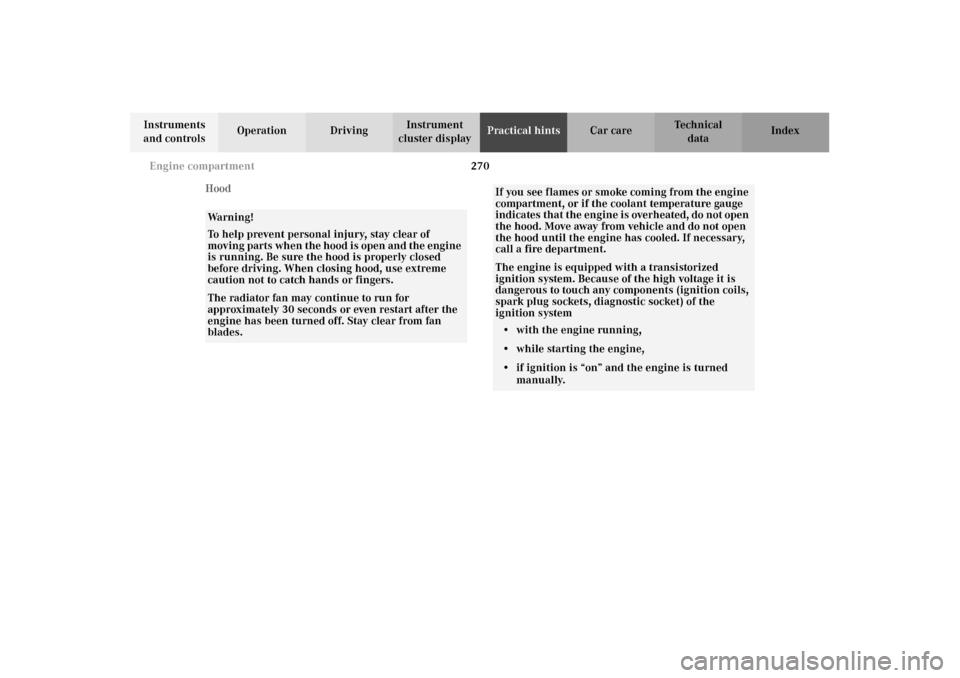
270 Engine compartment
Te ch n i c a l
data Instruments
and controlsOperation DrivingInstrument
cluster displayPractical hintsCar care Index
Hood
Wa r n i n g !
To help prevent personal injury, stay clear of
moving parts when the hood is open and the engine
is running. Be sure the hood is properly closed
before driving. When closing hood, use extreme
caution not to catch hands or fingers.The radiator fan may continue to run for
approximately 30 seconds or even restart after the
engine has been turned off. Stay clear from fan
blades.
If you see flames or smoke coming from the engine
compartment, or if the coolant temperature gauge
indicates that the engine is overheated, do not open
the hood. Move away from vehicle and do not open
the hood until the engine has cooled. If necessary,
call a fire department.The engine is equipped with a transistorized
ignition system. Because of the high voltage it is
dangerous to touch any components (ignition coils,
spark plug sockets, diagnostic socket) of the
ignition system
• with the engine running,
• while starting the engine,
• if ignition is “on” and the engine is turned
manually.
Page 276 of 354
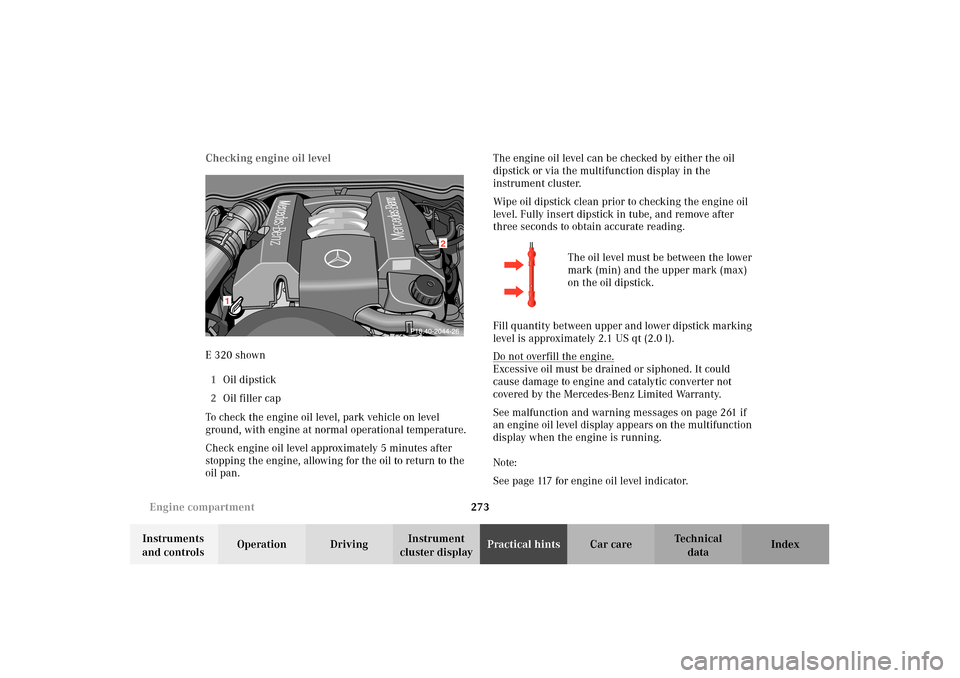
273 Engine compartment
Te ch n i c a l
data Instruments
and controlsOperation DrivingInstrument
cluster displayPractical hintsCar care Index Checking engine oil level
E 320 shown
1Oil dipstick
2Oil filler cap
To check the engine oil level, park vehicle on level
ground, with engine at normal operational temperature.
Check engine oil level approximately 5 minutes after
stopping the engine, allowing for the oil to return to the
oil pan.The engine oil level can be checked by either the oil
dipstick or via the multifunction display in the
instrument cluster.
Wipe oil dipstick clean prior to checking the engine oil
level. Fully insert dipstick in tube, and remove after
three seconds to obtain accurate reading.
The oil level must be between the lower
mark (min) and the upper mark (max)
on the oil dipstick.
Fill quantity between upper and lower dipstick marking
level is approximately 2.1 US qt (2.0 l).
Do not overfill the engine.
Excessive oil must be drained or siphoned. It could
cause damage to engine and catalytic converter not
covered by the Mercedes-Benz Limited Warranty.
See malfunction and warning messages on page 261 if
an engine oil level display appears on the multifunction
display when the engine is running.
Note:
See page 117 for engine oil level indicator.
2
1
Page 324 of 354
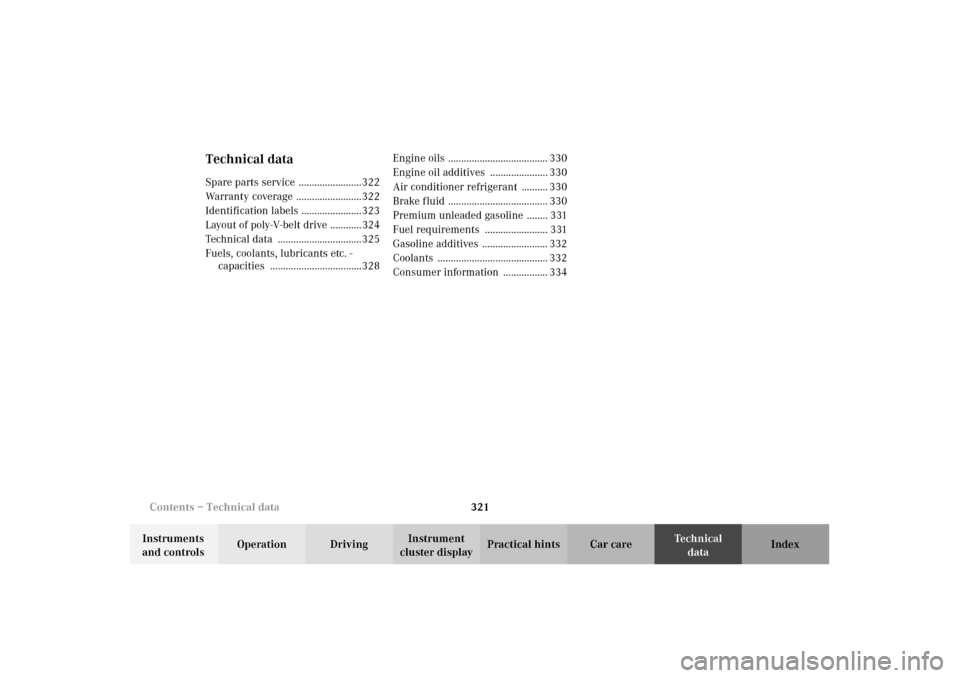
321 Contents – Technical data
Te ch n i c a l
data Instruments
and controlsOperation DrivingInstrument
cluster displayPractical hints Car care Index
Technical dataSpare parts service ........................322
Warranty coverage .........................322
Identification labels .......................323
Layout of poly-V-belt drive ............324
Technical data ................................325
Fuels, coolants, lubricants etc. -
capacities ...................................328Engine oils ...................................... 330
Engine oil additives ...................... 330
Air conditioner refrigerant .......... 330
Brake fluid ...................................... 330
Premium unleaded gasoline ........ 331
Fuel requirements ........................ 331
Gasoline additives ......................... 332
Coolants .......................................... 332
Consumer information ................. 334
Page 331 of 354
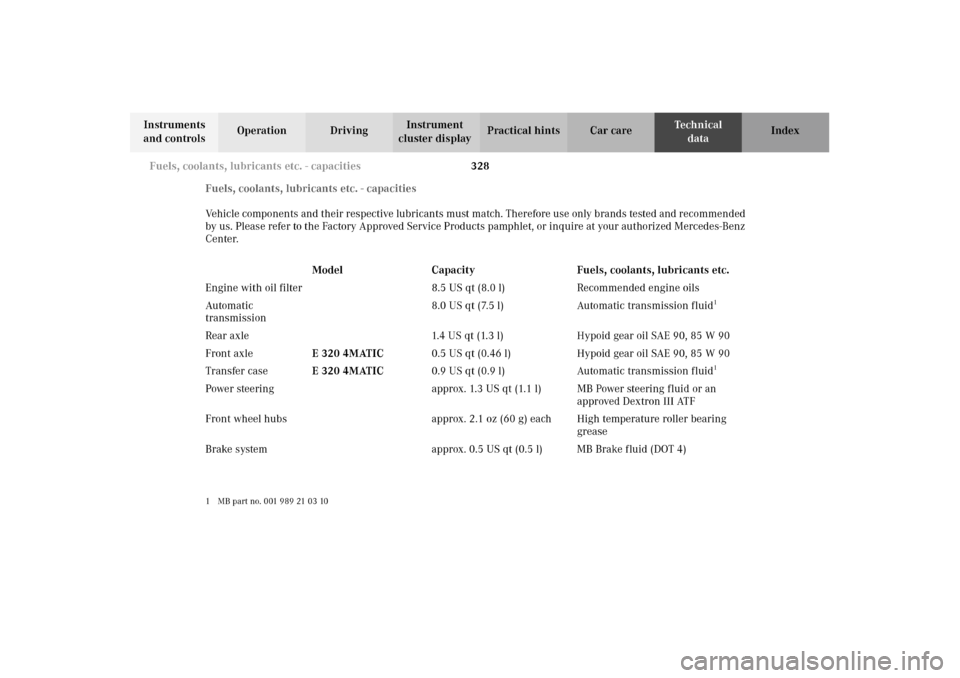
328 Fuels, coolants, lubricants etc. - capacities
Te ch n i c a l
data Instruments
and controlsOperation DrivingInstrument
cluster displayPractical hints Car care Index
Fuels, coolants, lubricants etc. - capacities
Vehicle components and their respective lubricants must match. Therefore use only brands tested and recommended
by us. Please refer to the Factory Approved Service Products pamphlet, or inquire at your authorized Mercedes-Benz
Center.
Model Capacity Fuels, coolants, lubricants etc.
Engine with oil filter 8.5 US qt (8.0 l) Recommended engine oils
Automatic
transmission8.0 US qt (7.5 l) Automatic transmission fluid
1
Rear axle 1.4 US qt (1.3 l) Hypoid gear oil SAE 90, 85 W 90
Front axleE 320 4MATIC0.5 US qt (0.46 l) Hypoid gear oil SAE 90, 85 W 90
Transfer caseE 320 4MATIC0.9 US qt (0.9 l) Automatic transmission fluid
1
Power steering approx. 1.3 US qt (1.1 l) MB Power steering fluid or an
approved Dextron III ATF
Front wheel hubs approx. 2.1 oz (60 g) each High temperature roller bearing
grease
Brake system approx. 0.5 US qt (0.5 l) MB Brake fluid (DOT 4) 1 MB part no. 001 989 21 03 10
Page 333 of 354

330 Fuels, coolants, lubricants etc. - capacities
Te ch n i c a l
data Instruments
and controlsOperation DrivingInstrument
cluster displayPractical hints Car care Index
Engine oils
Engine oils are specifically tested for their suitability in
our engines. Therefore, use only engine oils
recommended by Mercedes-Benz. Information on
recommended brands is available in the Factory
Approved Service Products pamphlet , or at your
authorized Mercedes-Benz Center.
Please follow Service Booklet recommendations for
scheduled oil changes. Failure to do so could result in
engine damage not covered by the Mercedes-Benz
Limited Warranty.
Engine oil additives
Do not blend oil additives with engine oil. They may be
harmful to the engine operation.
Damage or malfunctions resulting from blending oil
additives are not covered by the Mercedes-Benz Limited
Warranty.Air conditioner refrigerant
R-134a (HFC) refrigerant and special PAG lubricating oil
is used in the air conditioner system.
Never use R-12 (CFC) or mineral-based lubricating oil,
otherwise damage to the system will occur.
Brake fluid
During vehicle operation, the boiling point of the brake
fluid is continuously reduced through the absorption of
moisture from the atmosphere. Under extremely hard
operating conditions, this moisture content can lead to
the formation of bubbles in the system thus reducing
the system’s efficiency.
The brake fluid must therefore be replaced every two
years, preferably in the spring.
It is recommended to use only brake fluid approved by
Mercedes-Benz. Your authorized Mercedes-Benz Center
will provide you with additional information.
Page 334 of 354
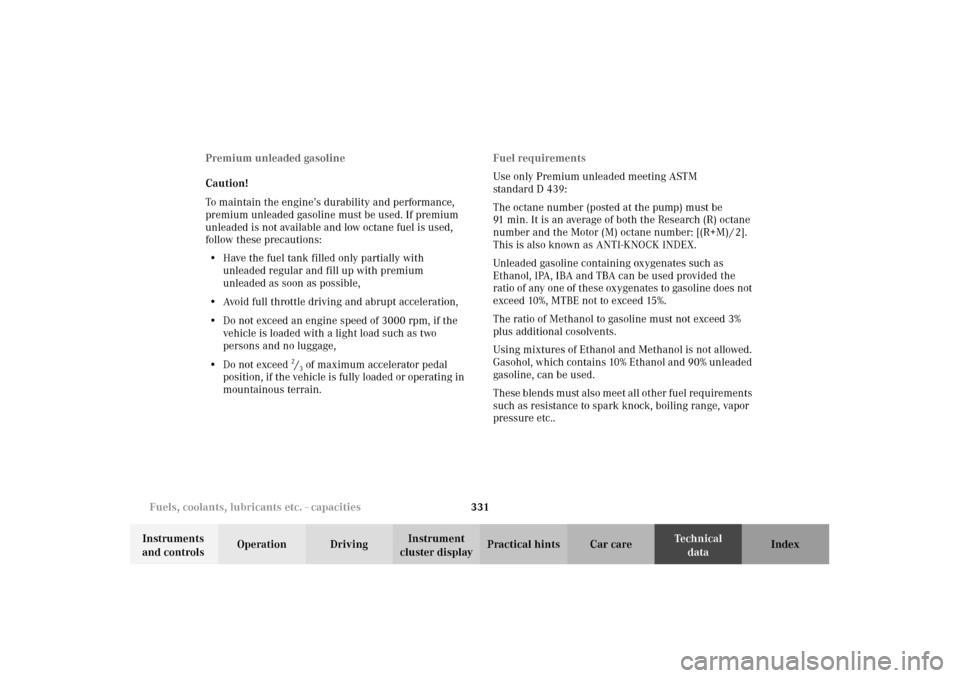
331 Fuels, coolants, lubricants etc. - capacities
Te ch n i c a l
data Instruments
and controlsOperation DrivingInstrument
cluster displayPractical hints Car care Index Premium unleaded gasoline
Caution!
To maintain the engine’s durability and performance,
premium unleaded gasoline must be used. If premium
unleaded is not available and low octane fuel is used,
follow these precautions:
•Have the fuel tank filled only partially with
unleaded regular and fill up with premium
unleaded as soon as possible,
•Avoid full throttle driving and abrupt acceleration,
•Do not exceed an engine speed of 3000 rpm, if the
vehicle is loaded with a light load such as two
persons and no luggage,
•Do not exceed
2/3 of maximum accelerator pedal
position, if the vehicle is fully loaded or operating in
mountainous terrain.Fuel requirements
Use only Premium unleaded meeting ASTM
standard D 439:
The octane number (posted at the pump) must be
91 min. It is an average of both the Research (R) octane
number and the Motor (M) octane number: [(R+M) / 2].
This is also known as ANTI-KNOCK INDEX.
Unleaded gasoline containing oxygenates such as
Ethanol, IPA, IBA and TBA can be used provided the
ratio of any one of these oxygenates to gasoline does not
exceed 10%, MTBE not to exceed 15%.
The ratio of Methanol to gasoline must not exceed 3%
plus additional cosolvents.
Using mixtures of Ethanol and Methanol is not allowed.
Gasohol, which contains 10% Ethanol and 90% unleaded
gasoline, can be used.
These blends must also meet all other fuel requirements
such as resistance to spark knock, boiling range, vapor
pressure etc..
Page 335 of 354
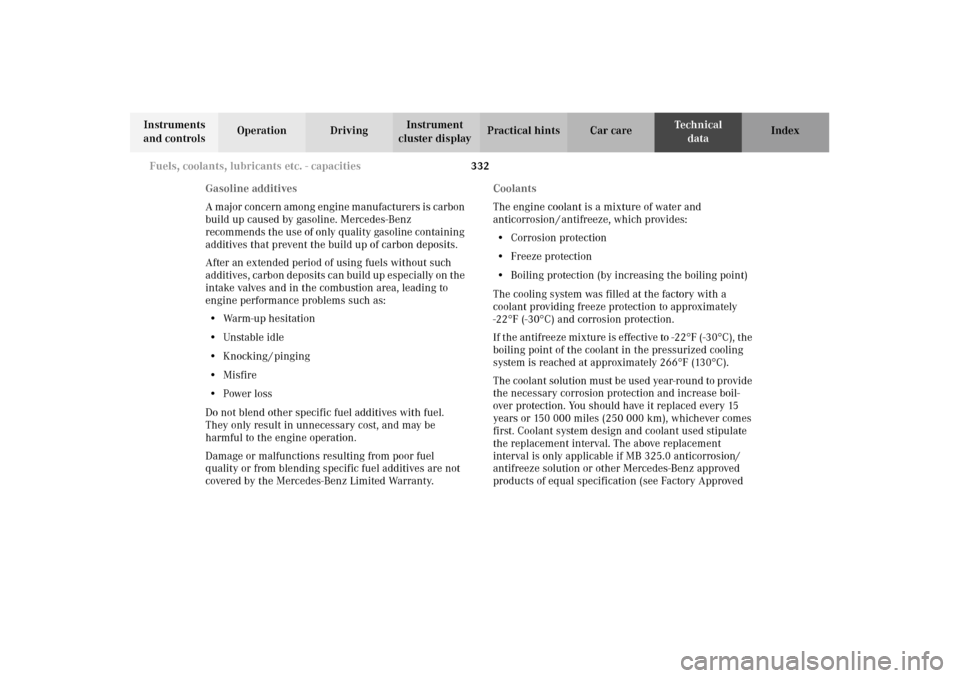
332 Fuels, coolants, lubricants etc. - capacities
Te ch n i c a l
data Instruments
and controlsOperation DrivingInstrument
cluster displayPractical hints Car care Index
Gasoline additives
A major concern among engine manufacturers is carbon
build up caused by gasoline. Mercedes-Benz
recommends the use of only quality gasoline containing
additives that prevent the build up of carbon deposits.
After an extended period of using fuels without such
additives, carbon deposits can build up especially on the
intake valves and in the combustion area, leading to
engine performance problems such as:
•Warm-up hesitation
•Unstable idle
•Knocking / pinging
•Misfire
•Power loss
Do not blend other specific fuel additives with fuel.
They only result in unnecessary cost, and may be
harmful to the engine operation.
Damage or malfunctions resulting from poor fuel
quality or from blending specific fuel additives are not
covered by the Mercedes-Benz Limited Warranty.Coolants
The engine coolant is a mixture of water and
anticorrosion / antifreeze, which provides:
•Corrosion protection
•Freeze protection
•Boiling protection (by increasing the boiling point)
The cooling system was filled at the factory with a
coolant providing freeze protection to approximately
-22
°F (-30
°C) and corrosion protection.
If the antifreeze mixture is effective to -22
°F (-30
°C), the
boiling point of the coolant in the pressurized cooling
system is reached at approximately 266
°F (130
°C).
The coolant solution must be used year-round to provide
the necessary corrosion protection and increase boil-
over protection. You should have it replaced every 15
years or 150 000 miles (250 000 km), whichever comes
first. Coolant system design and coolant used stipulate
the replacement interval. The above replacement
interval is only applicable if MB 325.0 anticorrosion/
antifreeze solution or other Mercedes-Benz approved
products of equal specification (see Factory Approved
Page 341 of 354
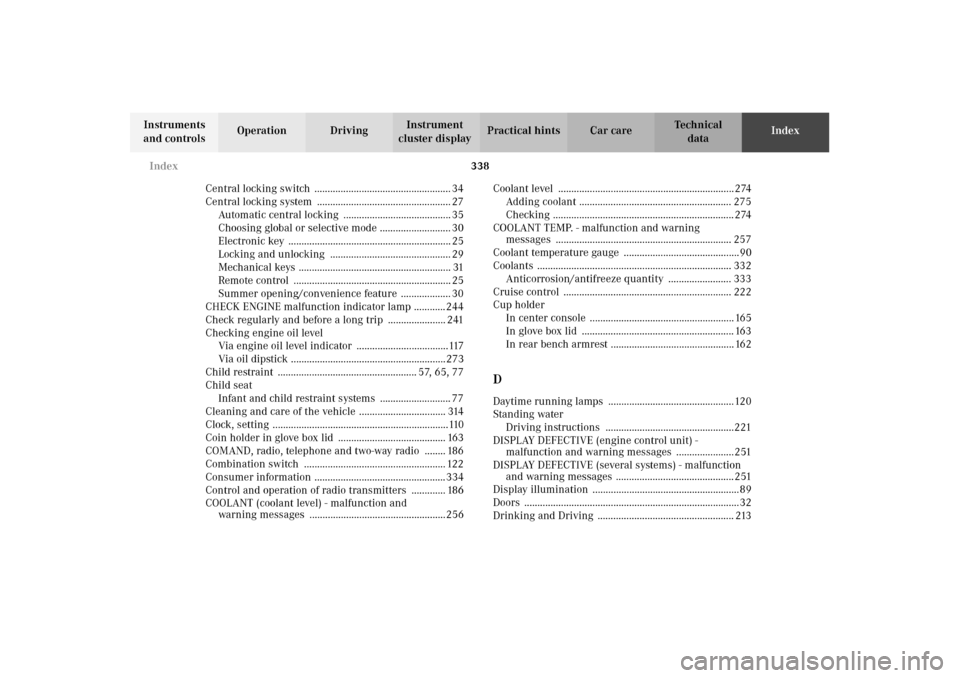
338 Index
Te ch n i c a l
data Instruments
and controlsOperation DrivingInstrument
cluster displayPractical hints Car careIndex
Central locking switch .................................................... 34
Central locking system ................................................... 27
Automatic central locking ......................................... 35
Choosing global or selective mode ........................... 30
Electronic key .............................................................. 25
Locking and unlocking .............................................. 29
Mechanical keys .......................................................... 31
Remote control ............................................................ 25
Summer opening/convenience feature ................... 30
CHECK ENGINE malfunction indicator lamp ............ 244
Check regularly and before a long trip ...................... 241
Checking engine oil level
Via engine oil level indicator ...................................117
Via oil dipstick ...........................................................273
Child restraint ..................................................... 57, 65, 77
Child seat
Infant and child restraint systems ........................... 77
Cleaning and care of the vehicle ................................. 314
Clock, setting ...................................................................110
Coin holder in glove box lid ......................................... 163
COMAND, radio, telephone and two-way radio ........ 186
Combination switch ...................................................... 122
Consumer information .................................................. 334
Control and operation of radio transmitters ............. 186
COOLANT (coolant level) - malfunction and
warning messages ....................................................256Coolant level ................................................................... 274
Adding coolant .......................................................... 275
Checking ..................................................................... 274
COOLANT TEMP. - malfunction and warning
messages ................................................................... 257
Coolant temperature gauge ............................................90
Coolants .......................................................................... 332
Anticorrosion/antifreeze quantity ........................ 333
Cruise control ................................................................ 222
Cup holder
In center console ....................................................... 165
In glove box lid .......................................................... 163
In rear bench armrest ............................................... 162
DDaytime running lamps ................................................120
Standing water
Driving instructions .................................................221
DISPLAY DEFECTIVE (engine control unit) -
malfunction and warning messages ......................251
DISPLAY DEFECTIVE (several systems) - malfunction
and warning messages ............................................. 251
Display illumination ........................................................89
Doors ..................................................................................32
Drinking and Driving .................................................... 213